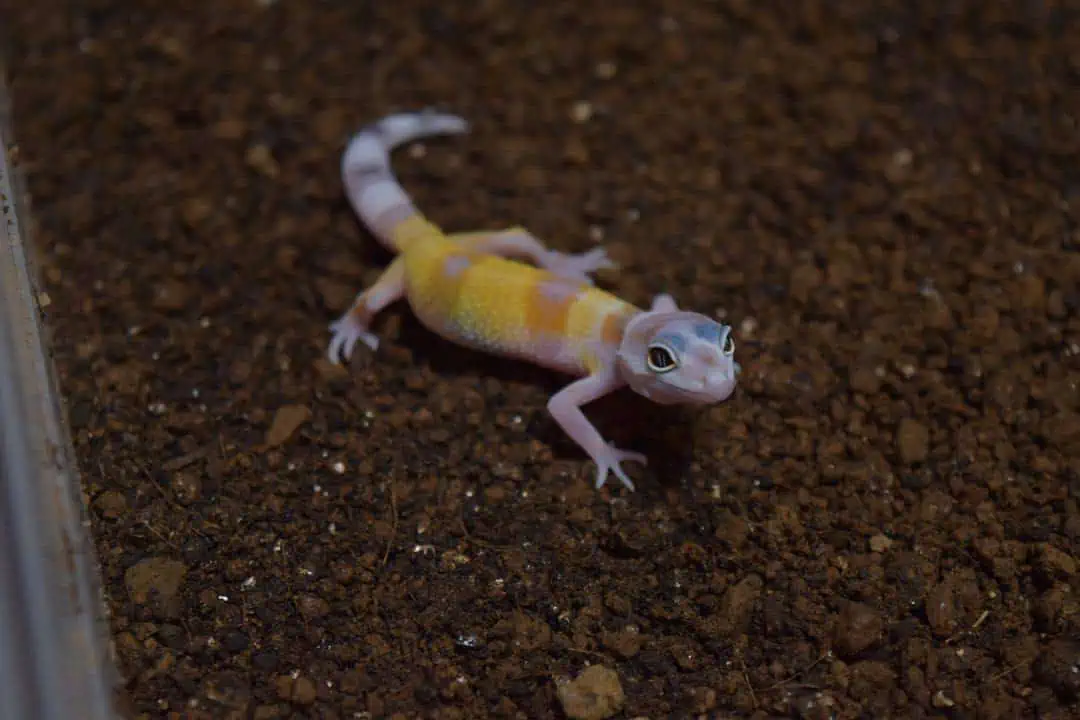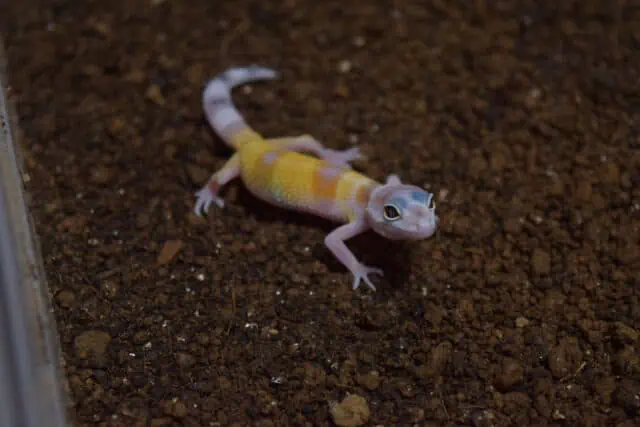When it comes to the health of our beloved reptilian pets, understanding the intricacies of their conditions is paramount. Leopard gecko ovarian cysts are a health concern that every gecko owner should be aware of. These cysts, which develop in the ovaries of female leopard geckos, can impact their overall well-being and reproductive capabilities.
What is an Ovarian Cyst in a Leopard Gecko?
An ovarian cyst in a leopard gecko is a health concern that many reptile enthusiasts encounter. These fluid-filled sacs, forming within the ovaries of the gecko, can influence their overall health and reproductive functions.
Common Causes of Ovarian Cysts in Leopard Geckos
Understanding the root causes of ovarian cysts in leopard geckos is crucial for effective prevention and treatment. In reproductive female leopard geckos, the ovaries play a pivotal role in egg production. However, sometimes, abnormalities like cysts can form, disrupting their natural functions.
The reproductive anatomy of a female leopard gecko is intricate. The ovarian bursa, a sac-like structure, houses the ovaries and is closely associated with blood vessels. This bursa is essential for the maturation and release of eggs. However, disruptions or anomalies in this system can lead to the formation of cysts.
Several factors can contribute to the development of ovarian cysts. Dysgerminoma, a type of tumor, can be a precursor to cyst formation. Additionally, neoplasia, an abnormal growth of tissue, can also lead to cystic formations in the ovaries.
The close association of the ovarian bursa with blood vessels means that any disruptions or blockages in these vessels can further exacerbate the risk of cyst development.
Diagnosis of Leopard Gecko Ovarian Cyst
Detecting an ovarian cyst in a leopard gecko early on is crucial for its well-being. A timely diagnosis not only aids in effective treatment but also helps in understanding the severity of the condition.
Clinical Signs of Ovarian Cysts in Leopard Geckos
Identifying ovarian cysts in leopard geckos begins with observing specific clinical signs. One of the most noticeable symptoms is a distended coelom, which refers to the swelling or bloating of the gecko’s abdominal cavity. This swelling can be a direct result of the cyst’s growth or the accumulation of fluids.
Another concerning symptom is cachexia, a condition where the gecko experiences significant weight loss and muscle wasting, even when it’s consuming a regular diet. This can be indicative of a larger underlying issue, such as an ovarian cyst.
In some cases, radiopaque foreign material might be present in the intestine. This material, visible during radiographic examinations, can signal the presence of a cyst or other abnormalities within the gecko’s reproductive system.
Ultrasonographic examination provides a more detailed look into the gecko’s internal structures. During this examination, the presence of a large mass adherent to the liver can be a clear sign of an ovarian cyst. Additionally, a thin-walled cystic structure near the liver or coelomic effusion (fluid accumulation within the abdominal cavity) can further confirm the diagnosis.
Lastly, during abdominal palpation, veterinarians might feel abnormal masses or swellings, indicating the presence of a cyst. Alongside this, a complete blood count (CBC) can provide insights into the leopard gecko’s health, and imaging tests, like X-rays or ultrasounds, can offer a visual confirmation of the cyst’s presence and size.
Abdominal Palpation
Abdominal palpation is a hands-on diagnostic technique that veterinarians use to detect abnormalities within an animal’s body. In the context of leopard geckos, this method is particularly valuable in identifying ovarian cysts.
The process involves the veterinarian gently feeling the gecko’s abdomen with their fingers. By applying slight pressure, they can detect any abnormal masses or swelling that might be present. This tactile examination allows them to identify areas that feel different from the surrounding tissue, which can be indicative of a cyst or other internal issues.
Locating the cyst is just the first step. It’s equally important to evaluate its size and consistency. A cyst might be soft and fluid-filled, or it could be firmer, suggesting a different composition. Understanding these characteristics can provide valuable insights into the nature of the cyst and the potential treatment options.
Complete Blood Count (CBC)
A Complete Blood Count (CBC) is a diagnostic procedure that holds immense significance when assessing the health status of animals, including leopard geckos. Especially in cases where a gecko is suspected to have an ovarian cyst, a CBC can provide a wealth of information about the overall health of the reptile.
The CBC analyzes various components of the blood. This includes red blood cells, which carry oxygen; white blood cells, which fight infections; and platelets, which help with clotting. By evaluating the levels and health of these cells, veterinarians can gain insights into the gecko’s immune response, potential anemia, or other underlying conditions.
For leopard geckos with an ovarian cyst, a CBC can highlight potential complications. For instance, an elevated white blood cell count might indicate an infection or inflammation, possibly related to the cyst. On the other hand, abnormalities in red blood cell count or platelets can suggest other health issues that might be indirectly related to the ovarian cyst.
Imaging Tests
Imaging tests play a pivotal role in the world of veterinary medicine, especially when diagnosing and evaluating conditions like ovarian cysts in leopard geckos. These tests provide a visual representation of what’s happening inside the gecko’s body, offering invaluable insights that might not be evident through physical examinations alone.
There are various types of imaging tests available for this purpose. Ultrasound, for instance, uses sound waves to produce images of internal structures. It’s particularly effective in visualizing soft tissues, making it an excellent tool for spotting and assessing ovarian cysts.
Radiography, commonly known as X-rays, is another powerful diagnostic tool. It provides clear images of denser structures, like bones, but can also highlight abnormalities like cysts, especially if they’re calcified or if they cause displacement of surrounding organs.
The importance of imaging tests can’t be overstated. Not only do they help in the initial diagnosis, but they also guide treatment decisions. For instance, the exact location, size, and characteristics of a cyst, as revealed through imaging, can determine whether surgical intervention is necessary or if a more conservative treatment approach can be adopted.
Furthermore, post-treatment, imaging tests serve as a monitoring tool, helping veterinarians track the response to therapy and ensuring that the cyst is resolving as expected.
Treatment Options
Addressing ovarian cysts in leopard geckos requires a tailored approach, as each case can present unique challenges. Fortunately, there are several treatment options available, ranging from surgical interventions to medical therapies and supportive care.
Surgical Removal
Surgical removal stands as one of the most definitive treatment options for ovarian cysts in leopard geckos. When a cyst poses significant health risks or discomfort to the gecko, removing it surgically can be the best course of action.
The procedure begins with a careful incision, typically made in the lower abdomen, granting access to the internal structures. Once inside, the surgeon identifies and isolates the affected structures, ensuring minimal disturbance to the surrounding tissues.
With precision, the cyst is then delicately removed, ensuring that no remnants are left behind, as these could lead to potential complications or recurrence. Following the successful removal of the cyst, the incision is meticulously closed, ensuring a clean and minimal scar.
The surgery requires specialized equipment and materials. This includes surgical instruments tailored for reptilian anatomy, such as fine-tipped forceps, scalpel blades, and sutures suitable for delicate reptile skin. Additionally, sterile drapes, gloves, and other standard surgical materials are essential to ensure a safe and infection-free procedure.
Medical Therapy
While surgical removal is a direct approach to addressing ovarian cysts in leopard geckos, medical therapy offers a less invasive alternative, especially when surgery might not be the most suitable option. Medical therapy focuses on treating the underlying causes and managing the symptoms associated with the cysts.
A notable concern linked with ovarian cysts in leopard geckos is the development of primary and secondary visceral gout. Visceral gout arises from the accumulation of uric acid crystals in the internal organs, often as a result of dietary imbalances or metabolic issues.
Primary visceral gout is a direct result of these imbalances, while secondary visceral gout occurs as a complication of another condition, such as an ovarian cyst.
Correcting the diet is paramount in treating visceral gout. This involves ensuring the gecko receives adequate hydration and a balanced diet, rich in essential nutrients but low in purines, which can contribute to uric acid buildup. Addressing underlying causes, like kidney dysfunction or metabolic disorders, is equally crucial.
Interestingly, drugs traditionally used to treat gout in humans, such as allopurinol, have shown promise in reptiles. If the diagnosis of gout is made early, these medications can be effective in reducing uric acid levels and alleviating symptoms.
Supportive Care and Management
Beyond direct treatments like surgery or medical therapy, supportive care and management play a pivotal role in the recovery and well-being of leopard geckos with ovarian cysts. This holistic approach ensures that the gecko not only recovers from the immediate ailment but also thrives in the long run.
Postoperative care is essential for geckos that undergo surgical removal of cysts. This involves monitoring the incision site for any signs of infection, ensuring the gecko is comfortable, and administering any prescribed medications to manage pain or prevent infections.
Regular follow-up examinations are crucial during this period to assess the healing process and ensure there are no complications.
A recommended medication regimen might be provided by the veterinarian, tailored to the specific needs of the gecko. This could include antibiotics, pain relievers, or other medications to address associated symptoms or prevent potential complications.
Environmental conditions play a significant role in the recovery process. Maintaining a suitable temperature is vital, as leopard geckos are ectothermic creatures, relying on external sources for body heat.
Ensuring their habitat has a proper temperature gradient allows them to self-regulate their body temperature, aiding in faster recovery.
Additionally, the overall environmental conditions, including humidity and cleanliness, should be optimal to prevent stress and promote healing.
Other steps in supportive care include fluid therapy, especially if the gecko is dehydrated, and pain management to ensure they remain comfortable. Continuous monitoring for any complications, changes in behavior, or signs of distress is essential, allowing for timely interventions if needed.
Prognosis and Complications
Understanding the prognosis and potential complications is vital for any leopard gecko owner dealing with ovarian cysts. While many geckos recover well with appropriate treatment, it’s essential to be aware of the various outcomes and challenges that might arise during the course of treatment.
The expected outcomes for leopard geckos with ovarian cysts can vary based on several factors. Generally, with early diagnosis and timely intervention, many geckos experience a favorable prognosis. They can return to their normal activities and exhibit typical behavior post-treatment.
However, potential complications can arise. The size of the cyst plays a significant role in determining the course of treatment and its success. Larger cysts might require surgical intervention, and with any surgery, there’s always a risk of postoperative complications, such as infections or issues with wound healing.
The overall health of the gecko is another crucial factor influencing the prognosis. A gecko in good health, with a robust immune system, is more likely to recover swiftly and face fewer complications. Conversely, a gecko with compromised health or existing conditions might face challenges during recovery, not to mention other diseases that may appear (mouth rot, an abscess, etc).
Secondary infections are a concern, especially if the cyst ruptures or if there are complications post-surgery. Such infections can exacerbate the condition and might require additional treatments, including a more aggressive medication regimen.






